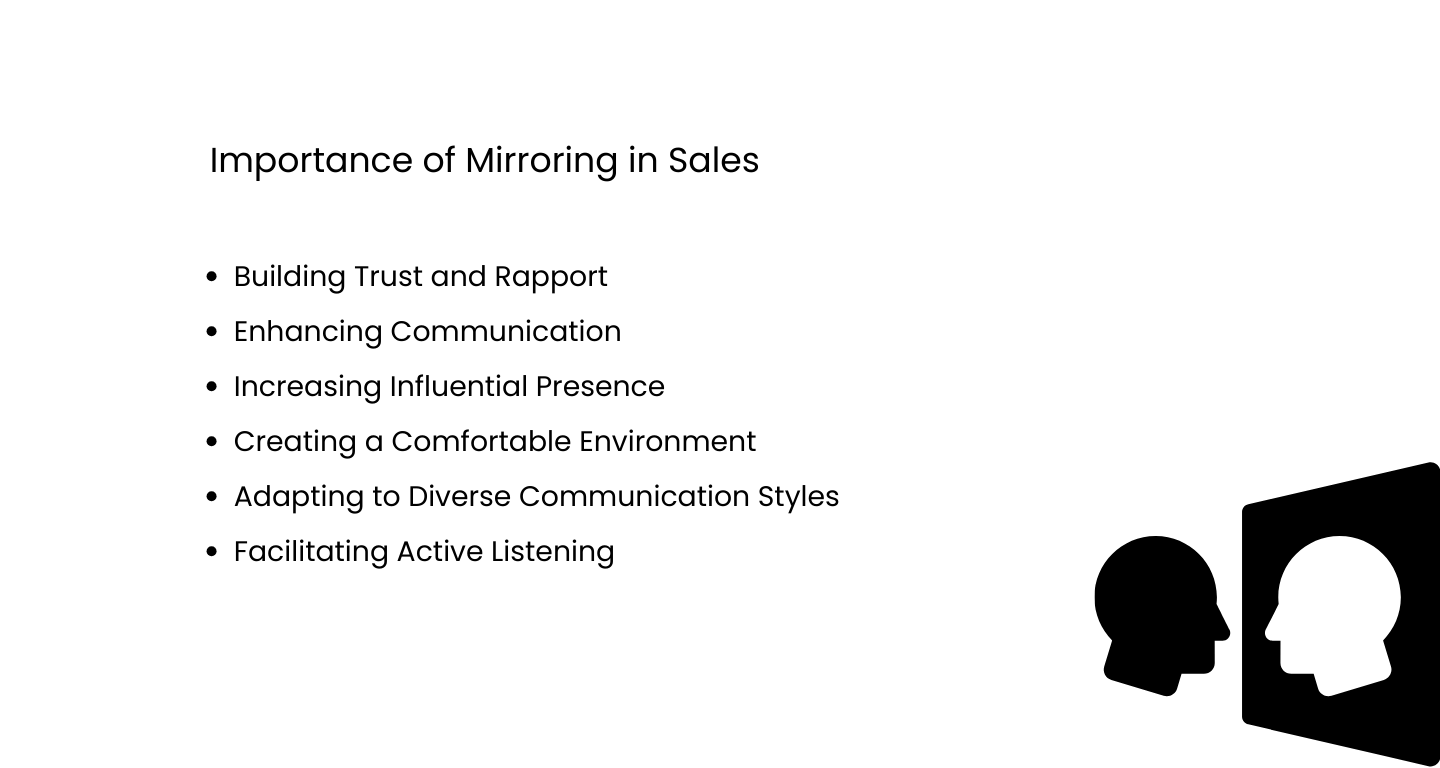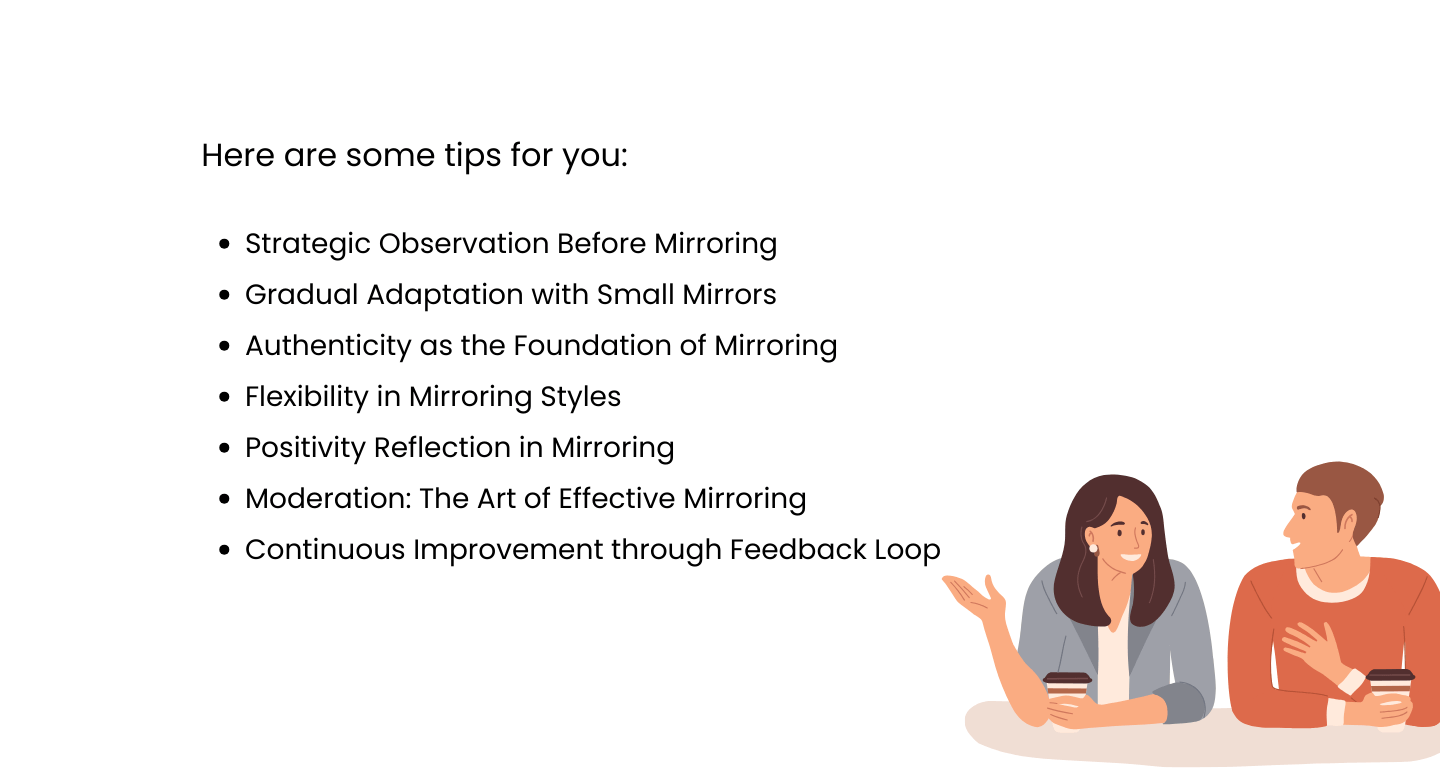Others
Sales Mirroring: Meaning, Benefits and Techniques
Article written by Kate Williams
Content Marketer at SurveySparrow
11 min read
19 September 2025

Psychology claims that mirroring your prospect’s movements can evoke a sense of trust within them. Sales mirroring, to be precise, is a strategic move used by successful businesses to connect with their customers.
Often hailed as the art of empathy in sales, it transcends conventional strategies.
(You must be lowkey, though.) It involves delicately aligning with your prospect’s behavior, communication style, and even non-verbal cues.
We’ll examine the meaning of mirroring in sales, its importance, benefits, tips, and strategies.
Before that, have you heard about the…
Mirroring Concept?
Have you ever noticed that when you’re talking with someone, you sometimes start acting a bit like them without realizing it? You copied their gestures, or maybe the way they picked their coffee mug? Or, you might have found yourself talking like them out of the blue!
The mirroring concept isn’t limited to just verbal communication. It extends to body language, tone of voice, and even the conversation pace. Successful mirroring creates a subtle dance of reciprocity, where both parties feel understood and connected.
That’s what we call mirroring. It’s like a social dance where we naturally copy each other’s body language, expressions, and even how fast we talk.
Now, let’s bring this idea into the sales world, shall we?
What is Sales Mirroring?
Sales Mirroring involves aligning your communication style with your prospect to establish a connection and rapport. Picture it as a tailored approach where you adjust your language, pace, and overall demeanor to mirror your customers’ preferences.
Here’s the thing: it is not just about mimicking gestures. When done strategically, it becomes a powerful tool for building rapport, fostering trust, and handling the intricacies of negotiation.
You start speaking your customers’ language!
If your customer loves details and specific facts, you might tailor your conversation to include those. If they prefer a more casual and friendly chat, you adjust accordingly.
The idea is to create a sense of familiarity that makes the customer feel more comfortable and understood – increasing the chances of a successful deal.
Importance of Sales Mirroring
Well, it’s all about understanding and connecting with your customers. And guess what? Mirroring helps you do just that.
It involves aligning your communication style with your prospect, creating a harmonious exchange beyond words.
But why is this alignment so important? Let’s see:

1. Building Trust and Rapport
Sales is all about relationships. Mirroring cultivates a sense of familiarity, making your prospect feel comfortable and building trust. It’s like speaking the same language, creating a foundation for a strong connection.
2. Enhancing Communication
Effective communication is key for sales. Adapting your style to match your prospects ensures your message is heard and understood. It eliminates communication barriers and promotes clarity.
3. Increasing Influential Presence
Mirroring goes beyond words. It extends to body language and overall presentation. When done well, it subtly communicates that you understand your prospect. This understanding elevates your influence in the conversation.
Most importantly, you become a persuasive force in that process!
4. Creating a Comfortable Environment
Sales conversations can be tense. Mirroring helps create a comfortable atmosphere by aligning with your prospect’s preferences. This comfort encourages openness and honesty, fostering a positive environment for negotiations.
5. Adapting to Diverse Communication Styles
Every prospect is unique. Mirroring allows you to adapt to diverse communication styles, ensuring you resonate with various personalities. This versatility is crucial in navigating different sales scenarios and connecting with a broad range of clients.
6. Facilitating Active Listening
Sales mirroring isn’t just about talking, all right? It’s about listening too.
You become more attuned to your prospect’s needs and concerns when you mirror effectively. This active listening skill is fundamental in tailoring your approach and addressing specific customer requirements.
Now, understanding your customers and clearly understanding their needs and preferences is crucial for successful businesses. But how can you achieve that when your audience base is vast and diverse? Rolling out surveys during each touchpoint might be an effective strategy!
Plus, if you have the assistance of an advanced online survey tool such as SurveySparrow, you can streamline the entire data collection process! The platform lets you create engaging surveys, share them on multiple platforms, collect data, analyze them, and act upon the rich insights gained!
Try it out for free!

Create conversational surveys with SurveySparrow
A personalized walkthrough by our experts. No strings attached!
Effective Sales Mirroring Techniques
Let’s assume you are a salesperson in conversation with a prospect. You notice they are the type who values detailed information, speaks in a calm and measured tone, and prefer a formal approach. Here’s how mirroring could play out:
1. Mirroring Communication Style
What is it? Aligning your words and language style with that of your prospect. This involves using similar vocabulary, tone, and communication patterns to create a sense of connection.
- If the prospect tends to use formal language and appreciates detailed explanations.
- As a salesperson, you respond by using a similar level of formality and providing in-depth information. You match their preference for a structured and detailed conversation.
2. Mirroring Tone and Pace
What is it? Mirroring body language, gestures, and facial expressions. By subtly reflecting your prospect’s non-verbal cues, you enhance the feeling of rapport and understanding.
- So, let’s say the prospect speaks calmly and composedly. Match their vibe!
- You adjust your tone and pace to match theirs, ensuring the conversation flows smoothly. This creates a sense of harmony and understanding.
3. Matching Non-Verbal Cues
This is more like emotional mirroring. What’s that?
Connecting on an emotional level by mirroring the prospect’s mood or energy. This involves adapting your emotional expression to match theirs, fostering a shared experience.
- For example, you have a prospect who exhibits positive body language, such as maintaining eye contact and using open gestures. What should you do?
- You subtly reflect these non-verbal cues by maintaining eye contact, using similar gestures, and creating a comfortable and open atmosphere. The key is to be lowkey!
4. Adapting Presentation Style
Whether they prefer a data-driven approach or a more narrative presentation, mirroring their style ensures your delivery meets their expectations.
- You observe the prospect seems to appreciate a methodical and well-organized presentation.
- When presenting information or pitching a product, you tailor your approach to their preference. This is beneficial for a structured and organized delivery.
5. Aligning with Preferred Mode of Interaction
Adapt your communication to your prospect’s preferred mode. It can be email, video calls, or messaging platforms. This type of mirroring respects the prospect’s communication comfort zone.
- If the prospect shows a preference for written communication over phone calls.
- Recognizing this, you adapt your communication method, perhaps by providing detailed written proposals or updates, aligning with their preferred mode of interaction.
Benefits of Sales Mirroring
If you’re still wondering, why invest time and effort in mastering sales mirroring? let me walk you through the advantages:
- Building Trust and Friendship: Speaking in a way they understand and relate to builds trust, making them more likely to see you as a friend than just a salesperson. You instantly become pals!
- Smooth Communication: Have you ever had a conversation that clicks? That’s what mirroring does. It makes sure your message is clear and understood, preventing any communication hiccups. It’s all about going with the flow.
- Being a Persuasive Speaker: It isn’t just about words but how you present yourself. When you do it right, it makes you more influential. Your prospect listens more because you’re on the same wavelength.
- Making the Conversation Comfortable: Sales talks can be tense, right? Mirroring helps by creating a comfortable atmosphere. Your prospect feels at ease, making them more open and honest during the conversation.
- Adapting to Different People: Everyone is different. Mirroring lets you adjust to different styles to connect with many people. It’s like having a superpower in understanding and talking to anyone.
- Listening to Your Prospect: I can’t stress more on this point! When you mirror well, you pay more attention to your prospect’s needs and wants. It makes you a better listener.
Sales Mirroring: Challenges
While sales mirroring is a powerful technique, keep yourself from making these two simple but apparent mistakes.
- Overdoing it: Excessive mirroring can come off as insincere or manipulative. Too much of a good thing can backfire. If you copy everything your prospect does, it might seem fake. Balance is key.
- Mismatched Signals: Misreading your prospect’s cues can lead to confusion. You want to mirror, not mimic. So, understanding their signals is crucial.
Best Practices for Effective Sales Mirroring

1. Observe First, Mirror Second
Take a moment to watch and understand your prospect before diving into mirroring. Please pay attention to their tone, pace, and language. This helps you pick up on their style without jumping in too quickly.
2. Start with Small Mirrors
Begin by mirroring more minor things like their tone or choice of words. Starting small allows the mirroring process to feel natural and unforced. As the conversation progresses, you can gradually match more aspects of their style.
3. Stay Genuine
Mirroring is about adapting, not pretending. Stay true to yourself while adjusting your approach. Authenticity builds trust. Genuine mirroring builds trust, while forced mirroring can be perceived as insincere.
4. Adapt to Changes
People shift in conversations. Be flexible with your mirroring; if they change their style, adjust accordingly to keep the connection strong. If your prospect shifts their communication style, be adaptable. This ensures a continued connection and understanding.
5. Mirror Positivity
Focus on positive aspects. If your prospect is upbeat, reflect that energy. It helps in creating a more enjoyable and engaging conversation. If they bring enthusiasm to the conversation, reflecting that energy enhances the overall mood and engagement.
6. Use Mirroring in Moderation
Like seasoning in cooking, mirroring is best when used in moderation. Please don’t overdo it! Sprinkle it strategically for the best effect. You need to sit and choose the elements to mirror.
7. Feedback Loop
Pay attention to how your prospect responds to your mirroring. Consider it a positive signal if they seem more engaged or comfortable with certain mirroring elements. Also, adjust if needed.
Wrap Up!
Sales mirroring shows the power of being subtle and assertive all at the same time. Going with the flow is crucial! By adapting your communication style to match your prospects, you create an environment of understanding, fostering trust and paving the way for successful deals.
However, like any tool, sales mirroring comes with its challenges. Overdoing it or misinterpreting cues can backfire. Hence, it’s essential to approach mirroring with finesse, observing, adapting, and staying genuine throughout the process.
Understand your audience and create a sense of belonging!
And, before you go, give SurveySparrow a try!

Create conversational surveys with SurveySparrow
A personalized walkthrough by our experts. No strings attached!

Thousands of brands trust SurveySparrow to turn feedback into growth. Try it free today!
Kate Williams
Related Articles

Others
Why Your Business Needs a SaaS CRM Solution
6 MINUTES
9 August 2020

Others
Artificial Intelligence: Shaping the Future of Humanity
5 MINUTES
30 May 2023

Others
Best Sales Productivity Tools to Boost Efficiency
7 MINUTES
24 March 2024

Others
The Beginner’s Guide to Build a Buyer Persona Effortlessly!
13 MINUTES
3 April 2020
